Current work and research interests
- Computer programs for electron diffraction analysis and crystallography. We developed the Landyne software suite for electron diffraction simulation and crystallographic analysis.
- TEM characterization on intermetallic alloys. I would be delightful to help you on TEM analysis work as collabration.
- HREM and electron diffraction study of crystal structures. I would be delightful to help you on HREM and SAED study of crystalline phases as collabration.
Honors
- Best poster prize for physics/material sciences(1998), Scandem98 conference, Espoo/Helsinki, Finland.
- Research fellowship (1994-1995), Alexander von Humboldt (AvH) Foundation.
- Youth scientist award (1993), Chinese Academy of Sciences.
Selected Publications
141 research papers have been published in peer-reviewed international scientific journals (not including contributions in conference proceedings). The research work includes the structures of intermetallic compounds (magnetic thin film, nanoparticles, precipitates, quasicrystals, crystalline approximants) by TEM, HREM, electron and X-ray diffraction techniques and computer programs for electron diffraction and crystallography.
- Revisiting calculation of tilt angles for double-tilt sample holders in transmission electron microscope, X.-Z. Li, Microscopy Research Technique, 1-6 (2024) .
- SVAT4 – a computer program for crystal structure visualization and analysis, X.-Z. Li, J. Appl. Cryst., 53, 848-853 (2020).
- SPICA - Stereographic Projection for Interactive Crystallographic Analysis, X.-Z. Li, J. Appl. Cryst., 49, 1818-1826 (2016) .
- PCED2.0: A computer program for the simulation of polycrystalline electron diffraction pattern, X.Z. Li, Ultramicroscopy, 110, 297-304 (2010).
- HREM Study and structure modeling of the eta-prim phase, the hardening precipitates in commercial Al-Zn-Mg alloys, X.Z. Li, V. Hansen, J. Gjonnes and L.R. Wallenberg, Acta Mater., 47, 2651-2659 (1999).
- Structure of Al-Rh-Cu Decagonal Quasicrystal: I. A unit-cell approach, X. Z. Li, K. Hiraga and K. Yubuta, Physica. B, 240, 330-337 (1997).
- Two-colour Penrose Tiling, X. Z. Li, J. M. Dubois and K. H. Kuo, Phil. Mag. Lett., 69, 93-98 (1994).
- Structure of Al3Mn, an Orthorhombic Approximant of the Decagonal Quasicrystal, X. Z. Li, D. Shi and K. H. Kuo, Phil. Mag., B66, 331-340 (1992).
HREM Study of Intermetallic Structure
High-resolution electron microscopic (HREM) study on the structure of the epsilon-Al3Co phase is briefly shown here. The epsilon-Al3Co phase (or Tao2 Al13Co4 in early reports) is a monoclinic phase with lattice parameters, a = 3.9863 nm, b = 0.8139 nm, c = 3.2208 nm, ß=107.96. The crystalline phase is structurally related to the Al-Co decagonal quasicrystal. A structural model of the crystalline phase has been successfully worked out, the calculated images based on the model agree with quite well the observed ones
(X.Z.Li and K. Hiraga, J. Alloys and Compounds, 269(1998) L13-L16).
The [010] HREM images of the epsilon-Al3Co phase (click to enlarge)
Observed images
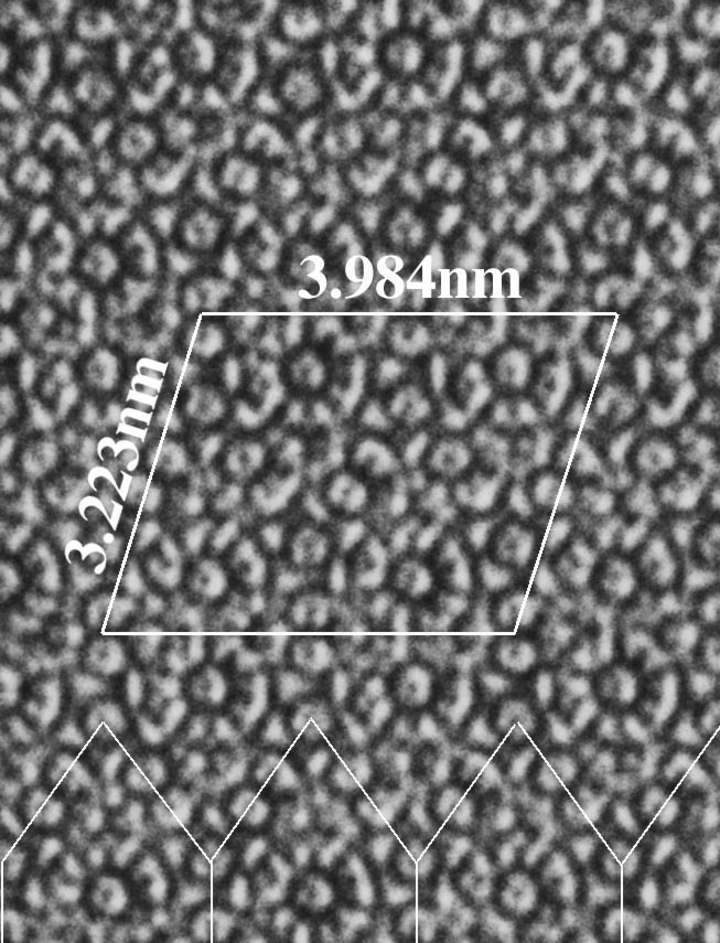
defocus -48 nm
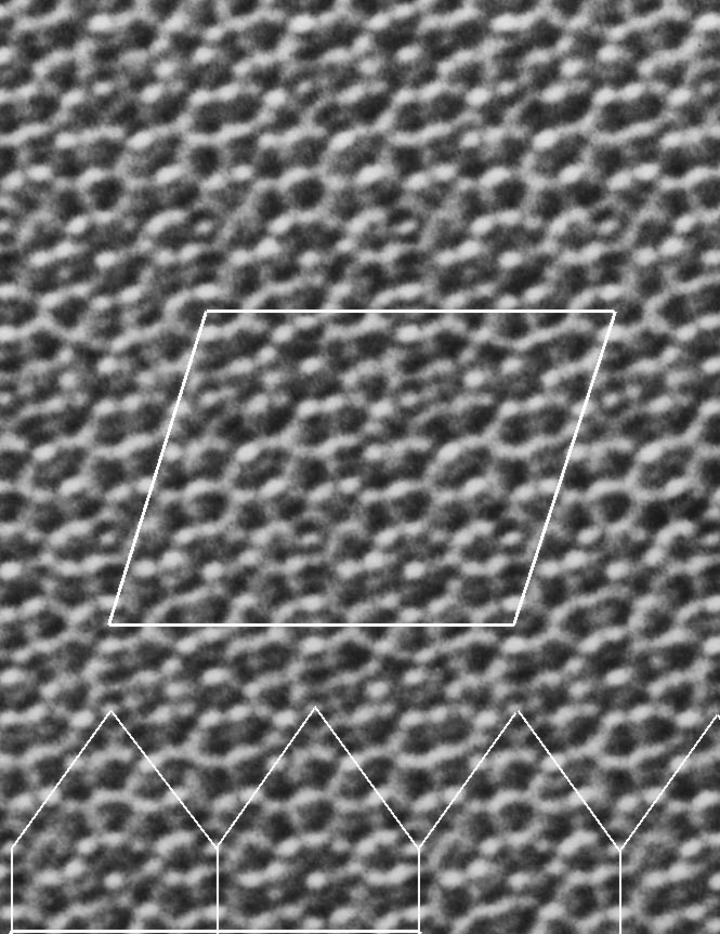
defocus -20 nm
Calculated images
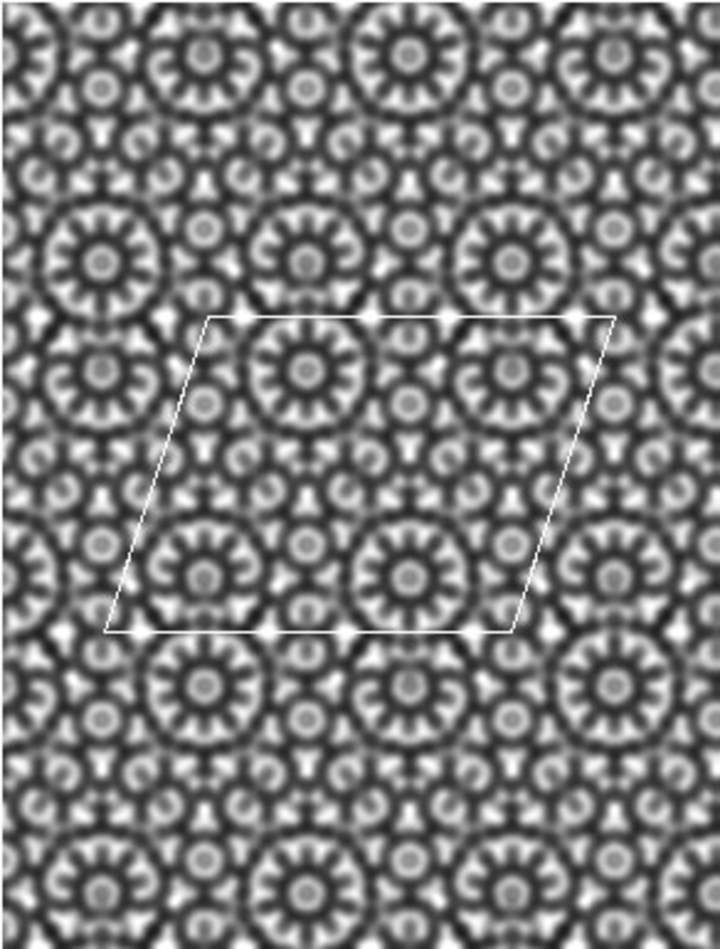
defocus -48 nm
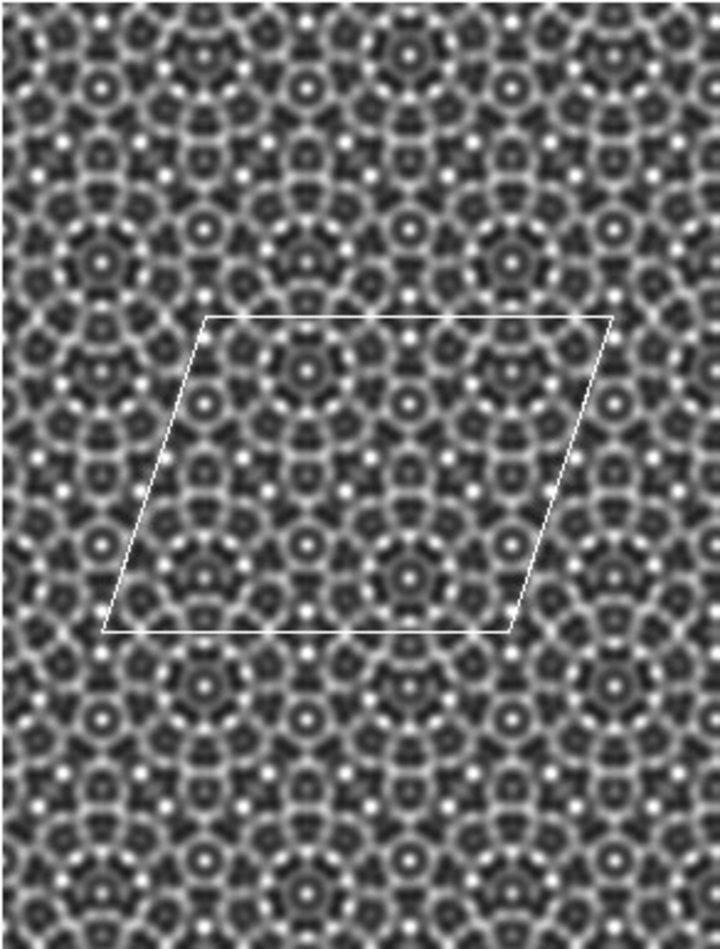
defocus -20 nm
Cross sectional TEM images of FePt magnetic thin film
Cross-sectional TEM study of the FePt/C thin film is briefly shown here. L10 nanocomposite FePt-based thin films attract attention for extremely high-density perpendicular recording media due to their high magnetic anisotropy. A L10nanocomposite FePt:C perpendicular thin film with a soft underlayer (SUL) was designed and prepared using a non-epitaxial growth method. The cross-sectional TEM image verifies that this medium consists of a nanocomposite FePt:C layer with FePt nanoparticles embedded in a C matrix and 150 nm soft FeCoNi underlayer.
(M.L. Yan, X.Z.Li, L. Gao, S.H. Liou, and D.J. Sellmyer, Applied Physics Letters, 83(2003) 3332-3334).
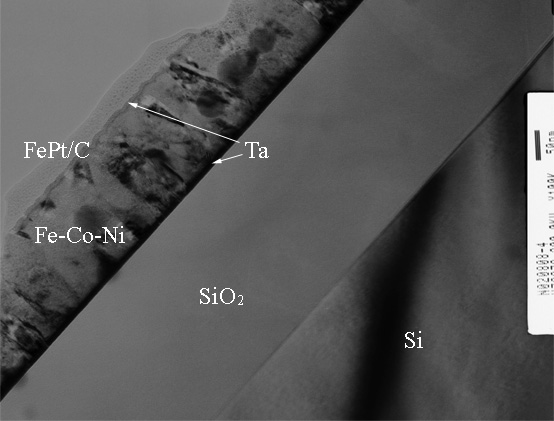
Teaching courses
Pre-session 2025 course (enrollment will be available in November 2024)
PHYS 492/892: High Resolution Electron Image and Crystallographic Image Processing
This pre-session course (1 credit hour/semester) will provide students with an introductory to theory on high-resolution electron microscopy and crystallography image processing, in combination with a practical software package available at the Nebraska Center for Materials and Nanoscience. It will help students enhance their ability to use the transmission electron microscope in their research work and broaden their horizons in analytical methods complementary to that area.
COURSE GRADE: Pass/No Pass. The grade will be given based on attendance and a final report. Students shall not miss more than one class. At the end of the course, all students must submit a two-page report on a selected topic covered in the course.
Instructor: Dr. XINGZHONG LI, Office: JH, 033, Phone: 402-472-8762
E-mail: xzli@unl.edu; Web: https://www.unl.edu/ncmn-enif/xzli/
The course meets on Jan. 2, 2025, 3:00 PM-4:30 PM at Nano Conference Room (N202 NANO). Please bring a notebook PC for software installation and usage.
Pre-session 2024 course
PHYS 492/892: Electron Diffraction Simulation and Crystallography Analysis
This pre-session course (1 credit hour/semester) will provide students with an introductory to theory on crystallography and electron diffraction, in combination with a practical software package available at the Nebraska Center for Materials and Nanoscience. It will help students enhance their ability to use the transmission electron microscope in their research work and broaden their horizons in analytical methods complementary to that area.
COURSE GRADE: Pass/No Pass. The grade will be given based on attendance and a final report. Students shall not miss more than one class. At the end of the course, all students must submit a two-page report on a selected topic covered in the course.
Instructor: Dr. XINGZHONG LI, Office: JH, 033, Phone: 402-472-8762
E-mail: xzli@unl.edu; Web: https://www.unl.edu/ncmn-enif/xzli/
The course meets on Jan. 2, 2024, 3:00 PM-4:30 PM at Nano Conference Room (N202 NANO). Please bring a notebook PC for software installation and usage.